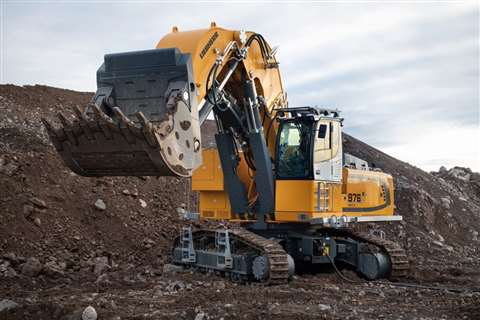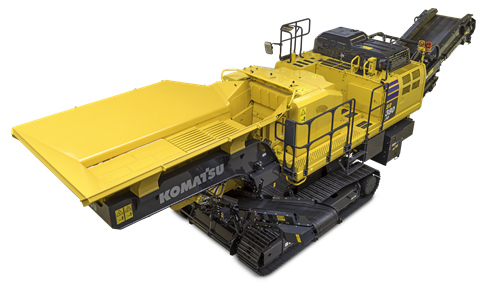A ‘whole system’ approach to lowering quarry emissions
07 July 2021
As Europe progresses with its carbon neutral mission, the region’s quarrying sector becomes a focal point for low emission innovations
When it comes to reducing the impact of construction industry activities on the environment, all sectors face difficulties. But few more so than the quarrying sector.
The sector is a major source of the embodied or ‘hidden’ carbon in our built environment because of the enormous quantities of material, large sites, giant machines and long operating hours involved.
Thus, it appears that we may have dug ourselves into rather a large hole. Now it is becoming increasingly clear that, in order to get out of said hole, everyone needs to take a ‘whole system’ approach if we are to significantly lower the emission levels we produce.
Improving equipment fuel efficiency
Recognising this, manufacturers are going to ever greater efforts to improve both the engine and the overall operational efficiency of their machines.
 The Cat 992 weighs 105.8 tonnes and is one of the company’s three biggest wheeled loaders. While the larger Cat 993K weighs 133.6 tonnes, the Cat 994 has an operating weight of 244.6 tonnes and is the biggest of the manufacturer’s wheeled loaders.
The Cat 992 weighs 105.8 tonnes and is one of the company’s three biggest wheeled loaders. While the larger Cat 993K weighs 133.6 tonnes, the Cat 994 has an operating weight of 244.6 tonnes and is the biggest of the manufacturer’s wheeled loaders.
Take the new Cat 992 wheeled loader for example. During field tests its Stage V compliant C32B engine proved to be 48% more efficient, in terms of payload-per-fuel than the company’s previous 992K wheeled loader.
It also provides up to 32% greater productivity and 10% lower maintenance costs, thanks to a new Z-bar linkage, improved rim pull, redesigned transmission, axles and final drive.
The model, which has standard-lift payload capacities of 23.1 tonnes for quarry face applications and 27.2 tonnes for loose material handling, also benefits from a 20% increase in breakout force.
Cat claims, “The 992 delivers the lowest cost-per-ton when compared with fleets of Cat 775, 777 and 785 trucks”.
Hybrid crushing and screening equipment
Metso Outotec, the Finland-based crushing and screening equipment manufacturer, has made significant advances with hybrid engines.
Kimmo Anttila, vice president of Lokotrack Solutions at Metso Outotec, said, “We introduced the first Lokotrack e-models 35 years ago, so we are one of the pioneers in this field.
“During the past couple of years the demand for hybrid solutions has really taken off, as environmental regulations have become increasingly stringent in more countries. Sales of the Lokotrack e-models have doubled in five years, and we expect the trend to accelerate.”
The company unveiled its new e-Power range of hybrid Lokotrack crushers and screeners last month. The diesel-electric range comprises 15 new crushers and six screens, representing the broadest portfolio of this type of hybrid mobile equipment.
 Metso Outotec Lokotrack e-model sales have doubled over the past five years
Metso Outotec Lokotrack e-model sales have doubled over the past five years
Metso says the new range, which forms part of its “Planet Positive” strategy, demonstrates its commitment to helping limit global warming to 1.5 degrees Celsius as set out in the Paris Agreement.
The new e-Power machines, compared to similar models made by the company in 2010, produce around 20,000 tonnes less CO2 each year courtesy of their lower fuel consumption.
The hybrid driveline of the new Lokotrack units also use roughly 80% less hydraulic oil and lubricant to further ease their environmental impact.
Anttila added, “We give consideration to the total fuel consumption, including the engine and driveline technologies, but also to other factors such as the unit transportation weight and the engine stand-by function.”
Electric excavators
Liebherr’s new R976-E electric crawler excavator is specifically designed for mine and quarry material extraction, and features a 400kW electric power system that offers zero CO2 emissions during operation.
Replacing the company’s ER 974 B model, the new 90 tonne R976-E excavator is powered by a high voltage 6000 V/50Hz current collector. It incorporates a low-voltage electric squirrel-cage engine, which drives the hydraulic system.
 The Liebherr R976-E electric crawler excavator is designed for mine and quarry material extraction
The Liebherr R976-E electric crawler excavator is designed for mine and quarry material extraction
The Stage V compliant excavator, developed and produced entirely by Liebherr-France SAS, has a maximum shovel capacity of 6.0m3 and is available in both backhoe and shovel versions.
Capable of withstanding the “extreme working conditions” on quarrying sites, the model’s two electrical cabinets are welded into its structure. The engine features heat shielding on both bearings and motor windings.
Liebherr explained, “Reduced maintenance and lower operating costs make an electric excavator more cost-effective than a diesel-engine machine.
“The robustness, reliability and cost-effectiveness of the R 976-E and R 980 SME-E make them products of choice for environmentally-friendly extraction applications.”
Low emission diesel crushers
The new Komatsu BR380JG-3 mobile jaw crusher is also geared towards lowering CO2 emissions. Described by the manufacturer as “the cleanest mobile crusher in the market”, the mobile jaw crusher features a Stage V compliant diesel engine and comes with a CO2 off-setting scheme to help users meet their low emissions targets.
Vince Porteous, product manager at Komatsu Europe, enthused, “The new BR380JG-3 is Komatsu’s first diesel-powered machine in Europe with net zero CO2 emissions.”
 Komatsu launched the net zero emissions BR380JG-3 mobile jaw crusher on international Earth Day in April 2021.
Komatsu launched the net zero emissions BR380JG-3 mobile jaw crusher on international Earth Day in April 2021.
The model was launched to coincide with this year’s International Earth Day (22 April). It has become the successor to the company’s BR380JG-1 machine. The BR380JG-3, unlike its predecessor, comes with Komatsu’s standard radio remote control and a new one-touch start and stop function for easy operation.
It features a semi-automatic feeding system and automatic feed control with crusher overload detection for improved production.
Designed for high volumes of material, it has an operating weight of 35.3 tonnes, a maximum crushing capacity of 240 tonnes per hour and can deposit material stockpiles of 37 tonnes before needing to be moved.
Komatsu has also equipped the crusher with a high-resolution display panel, so that users can access real time machine information and fuel consumption data.
The BR380JG-3 comes with the Komtrax telematics system, which provides reports on the machine’s status, fuel consumption and the health and maintenance status of its engine’s aftertreatment system.
Porteous added, “By combining Komatsu technology with the assistance of biology, we – as a manufacturer of construction and mining equipment, and as a member of society – can deliver on our commitment to our customers and to the planet”.
While quarry operators are being spoiled for choice with the range of more eco-friendly equipment on the market, another factor that comes into play is the ‘hidden’ carbon in the equipment itself.
Digitising quarry operations
With the next power revolution already on the horizon, increasing attention is now being placed on how digital innovations can improve quarrying operations.
According to drilling and blasting specialist EPC-UK, digital innovations can make a significant impact on productivity and emission levels.
At this year’s Hillhead Digital event, streamed online in March, EPC-UK’s virtual booth featured the ‘Digital Quarry’ to showcase how their EPC Metrics could contribute.
Liam Bermingham, explosives engineer at EPC-UK said, “It is now possible to digitally measure, store and analyse data throughout the entire drill and blast process – from surveying and design, to measuring the resulting blast performance – a service EPC-UK has been offering its customers for a number of years in the form of EPC Metrics.
“The use of drone photogrammetry surveys, applications to record infield drilling and explosives measurements, and Cloud-based storage – together with the ability to perform fragmentation analysis – are allowing for a fully digitised blasting process.
In its presentation at Hillhead Digital the company explored “how a digital quarry, alongside mobile plant telematic systems, can make a significant impact on productivity, effectiveness, and most importantly on safety.”
Ryan Ward, commercial manager at EPC-UK, explained, “The aim of EPC Metrics is to provide customers with state-of-the-art techniques and technologies that are applied, conducted and analysed by our expert engineering team by incorporating drones, fixed remote monitoring, equipment sale and hire, equipment repair and calibration and a consultancy service.”
“Having the ability for our EPC Metrics and explosives engineering teams to work together also allows us to offer a true 360° service – from compliance and design to initiation and blast.
“However, each EPC Metrics provision is available as a standalone service, providing all our customers with even more flexibility and the ability to create a blasting service that is truly tailored to their specific needs.”
Regardless of where quarry operators are in their digital transition, the opportunities for reducing CO2 emissions have never been easier for companies to adopt.
Although the quarrying industry faces a tougher time making their activities more eco-friendly than most, the sector could soon be the one setting the standard for low-carbon operations.
STAY CONNECTED


Receive the information you need when you need it through our world-leading magazines, newsletters and daily briefings.




